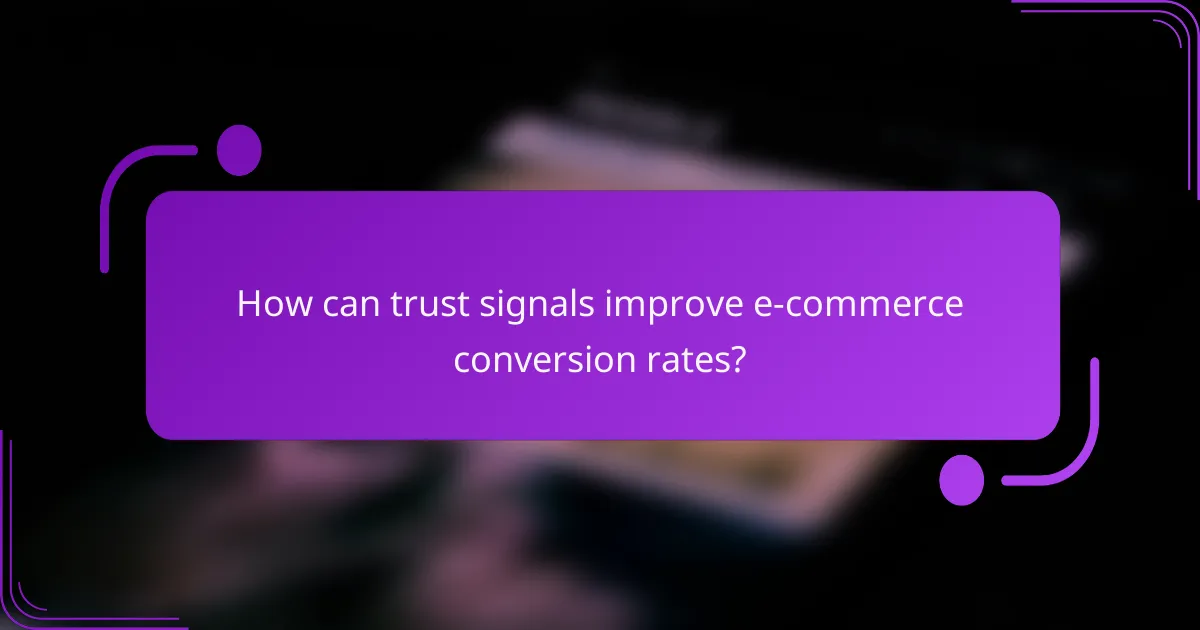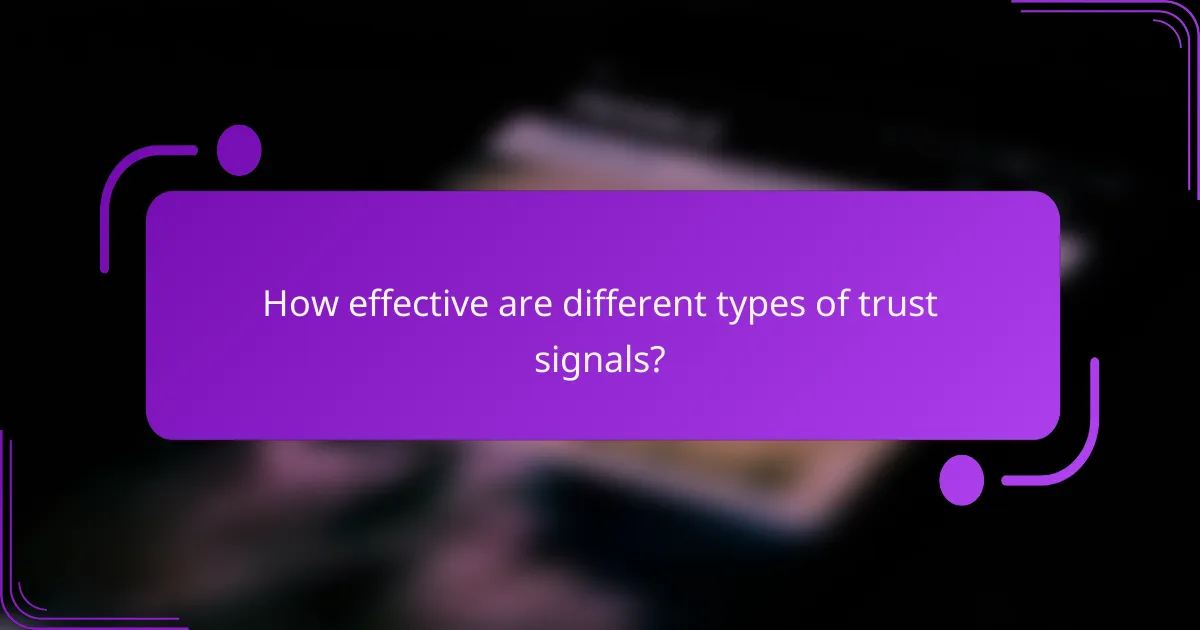In the competitive landscape of e-commerce, trust signals play a crucial role in enhancing conversion rates by reassuring customers about the safety and reliability of their purchases. Elements such as customer reviews, security badges, and transparent return policies not only build credibility but also reduce perceived risk, ultimately leading to increased sales and customer loyalty.

How can trust signals improve e-commerce conversion rates?
Trust signals can significantly enhance e-commerce conversion rates by reassuring customers about the safety and reliability of their purchases. By incorporating elements that convey credibility, businesses can reduce hesitation and encourage more transactions.
Customer reviews and ratings
Customer reviews and ratings serve as powerful trust signals, as they provide social proof of product quality and service reliability. Displaying a mix of positive and constructive feedback can help potential buyers feel more confident in their decisions.
Encourage satisfied customers to leave reviews by offering incentives, such as discounts on future purchases. Aim for an average rating of at least 4 out of 5 stars to effectively influence new customers.
Security badges and certifications
Security badges and certifications indicate that a website meets certain safety standards, which can alleviate concerns about data protection. Common badges include SSL certificates and PCI compliance logos, which assure customers that their payment information is secure.
Make sure these badges are prominently displayed during the checkout process, as this can reduce cart abandonment rates. Regularly update and verify these certifications to maintain credibility.
Social proof through user-generated content
User-generated content, such as photos and testimonials shared by customers, acts as a compelling form of social proof. This content not only showcases real-life use of products but also fosters a sense of community among buyers.
Encourage customers to share their experiences on social media by creating a unique hashtag or running contests. Highlight this content on your website to build trust and authenticity.
Transparent return policies
Transparent return policies can significantly enhance customer trust by removing the fear of making a wrong purchase. Clear, straightforward return guidelines reassure customers that they can return items if they are not satisfied.
Consider offering a hassle-free return process with a time frame of 30 days or more. Clearly outline the steps for returns on your website, and ensure that this information is easily accessible during the shopping experience.
Professional website design
A professional website design conveys credibility and fosters trust among potential customers. A clean, user-friendly interface with intuitive navigation can enhance the overall shopping experience and encourage conversions.
Invest in high-quality images, consistent branding, and mobile optimization. Regularly update your website to ensure it remains visually appealing and functional, which can help retain customer interest and trust.

What impact do trust signals have on consumer behavior?
Trust signals significantly influence consumer behavior by enhancing credibility and reducing perceived risk. These signals, such as customer reviews and security badges, can lead to increased sales and customer loyalty.
Increased purchase confidence
Trust signals boost purchase confidence by reassuring customers about the safety and reliability of their transactions. When shoppers see recognizable security logos or positive reviews, they feel more secure in their decision to buy.
For example, displaying a well-known payment processor’s logo can enhance trust, making customers more likely to complete their purchases. Clear return policies and customer service contact information further reinforce this confidence.
Reduced cart abandonment rates
Effective trust signals can lead to lower cart abandonment rates by addressing common customer concerns. When shoppers perceive a website as trustworthy, they are less likely to leave items in their cart without completing the purchase.
Implementing features like live chat support or displaying customer testimonials during the checkout process can help alleviate doubts and encourage users to finalize their transactions.
Higher average order values
Trust signals can contribute to higher average order values by encouraging customers to add more items to their carts. When consumers feel secure, they are more inclined to explore additional products and make larger purchases.
Offering free shipping thresholds or highlighting bulk discounts alongside trust signals can further entice customers to increase their order size, ultimately boosting overall sales revenue.

How effective are different types of trust signals?
Different types of trust signals can significantly enhance e-commerce conversion rates by reassuring customers about the credibility and reliability of a brand. Effective trust signals include customer reviews, security badges, and clear return policies, each playing a unique role in influencing buyer behavior.
Comparison of trust signal types
Trust signals can be categorized into several types, including social proof, security assurances, and transparency indicators. Social proof, such as customer testimonials and user-generated content, can increase perceived reliability, while security badges reassure customers about safe transactions. Transparency indicators, like clear return policies and detailed product descriptions, help build trust through openness.
When comparing effectiveness, social proof often leads to higher engagement rates, while security signals can reduce cart abandonment. A combination of these signals typically yields the best results, as they address various customer concerns simultaneously.
Case studies of successful e-commerce brands
Many successful e-commerce brands leverage trust signals effectively. For instance, Amazon prominently displays customer reviews and ratings, which significantly influence purchasing decisions. Their use of verified purchase badges adds credibility, encouraging more users to trust the feedback.
Another example is Zappos, which emphasizes its customer service and return policy. By showcasing a hassle-free return process, they build confidence among potential buyers, resulting in higher conversion rates. These case studies highlight the importance of integrating multiple trust signals to enhance overall effectiveness.
Industry-specific trust signal effectiveness
The effectiveness of trust signals can vary by industry. In the fashion sector, high-quality images and customer reviews are crucial, as buyers often rely on visual appeal and social proof. Conversely, in the tech industry, detailed product specifications and security certifications are more influential, as customers prioritize reliability and safety.
Additionally, industries like travel and hospitality benefit greatly from user-generated content, such as reviews and ratings on platforms like TripAdvisor. Understanding the specific trust signals that resonate within your industry can help tailor strategies to boost conversion rates effectively.

What are the best practices for implementing trust signals?
Implementing trust signals effectively enhances customer confidence and can significantly boost conversion rates. Best practices include strategic placement, integration into checkout processes, and ongoing testing to ensure effectiveness.
Placement of trust signals on product pages
Trust signals should be prominently displayed on product pages to reassure potential buyers. Common placements include near product descriptions, pricing information, and add-to-cart buttons. For example, displaying security badges or customer reviews close to the purchase options can enhance credibility.
Consider using contrasting colors or larger fonts to make trust signals stand out. A/B testing different placements can help determine which locations yield the highest engagement and conversion rates.
Integrating trust signals in checkout processes
In the checkout process, trust signals are crucial for reducing cart abandonment. Include security icons, such as SSL certificates, and clear return policies on the checkout page. This transparency helps alleviate concerns about payment security and order fulfillment.
Additionally, displaying customer testimonials or trust badges during checkout can reinforce buyer confidence. Ensure that these signals are visible without cluttering the interface, maintaining a smooth user experience.
Testing and optimizing trust signals
Regularly testing and optimizing trust signals is essential for maintaining their effectiveness. Use A/B testing to compare different trust signals and placements, analyzing which combinations lead to higher conversion rates. Metrics to monitor include click-through rates and overall sales performance.
Gather feedback from users to understand their perceptions of trust signals. Adjustments based on user behavior and preferences can lead to improved trust and increased sales over time.

What are the prerequisites for enhancing conversion rates?
To enhance conversion rates, e-commerce businesses must establish trust signals, optimize user experience, and ensure a seamless checkout process. These elements work together to build customer confidence and encourage purchases.
Trust Signals
Trust signals are essential for reassuring customers about the safety and reliability of their transactions. Common trust signals include security badges, customer reviews, and clear return policies. Incorporating these elements can significantly reduce hesitation during the buying process.
For example, displaying well-known security certifications, such as SSL certificates, can enhance perceived security. Additionally, showcasing positive customer testimonials can build credibility and encourage new visitors to make a purchase.
User Experience
A smooth user experience is crucial for keeping potential customers engaged. This includes intuitive navigation, fast loading times, and mobile optimization. A website that is easy to navigate can lead to higher conversion rates as users can find what they need quickly.
Consider conducting usability tests to identify pain points in the shopping journey. Aim for loading times under three seconds and ensure that the site is responsive across various devices. Simple design changes can lead to significant improvements in user satisfaction.
Seamless Checkout Process
A seamless checkout process minimizes cart abandonment and encourages completed purchases. This involves reducing the number of steps required to finalize a transaction and offering multiple payment options. A lengthy or complicated checkout can deter customers from completing their orders.
Implement features like guest checkout and auto-fill forms to streamline the process. Additionally, displaying progress indicators during checkout can help manage customer expectations and reduce anxiety about the transaction.
